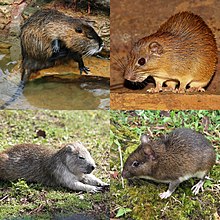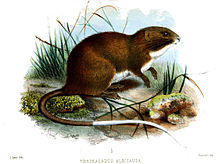Characteristics
In general form, most spiny rats resemble rats, although they are more closely related to guinea pigs and chinchillas. Most species have stiff, pointed hairs, or spines, that presumably serve for protection from predators.
Many echimyids can break off their tails when attacked. This action may confuse predators long enough for the spiny rat to escape. Unlike the tails of some species of lizards, however, the tails of spiny rats do not regenerate. Therefore, the tactic can only be used once in an individual's lifetime.
Most spiny rats are rare and poorly known, but a few are extremely abundant. Various species are respectively terrestrial, arboreal, or fossorial. In general, the arboreal forms are most rat-like in appearance, whilst the burrowing species are more gopher-like, with stocky bodies and short tails. Most species do poorly in conditions of high heat and aridity and are restricted to regions with abundant water. They are almost exclusively herbivorous.
Systematics
The current taxonomic content of the family Echimyidae has been reshaped over time, and its organization into coherent units stems from two realizations. The first is that cladistic approaches applied to morphological characters showed that many traits used to define taxa were plesiomorphic or homoplastic. The second realization came from the advent of phylogenetic analyses of DNA sequence and protein sequence data with probability methods — maximum likelihood and Bayesian inference — leading to the identification of robust clades and the recognition of higher categorical ranks (see Phylogeny section). [5] [6] The following table recapitulates and compares the taxonomic content of taxa recognized on molecular and traditional basis: the two families Capromyidae and Myocastoridae, the five subfamilies Echimyinae, Euryzygomatomyinae, Capromyinae, Dactylomyinae, Eumysopinae, and the four tribes Echimyini, Myocastorini, Capromyini, and Plagiodontini.
Extant genera
- Family Echimyidae - spiny rats
Comparison between molecular-based [5] [6] [7] and traditional [3] [8] systematics
for extant Echimyidae and Capromyidae genera| Genus | Vernacular name | Molecular-based subfamily | Molecular-based tribe | Traditional systematics |
|---|
| Echimys | arboreal spiny rats | Echimyinae | Echimyini | Echimyinae |
| Phyllomys | Atlantic tree-rats | Echimyinae | Echimyini | Echimyinae |
| Makalata | — | Echimyinae | Echimyini | Echimyinae |
| Pattonomys | — | Echimyinae | Echimyini | Echimyinae |
| Toromys | giant tree-rat | Echimyinae | Echimyini | Echimyinae |
| Diplomys | — | Echimyinae | Echimyini | Echimyinae |
| Santamartamys | red-crested tree-rat | Echimyinae | Echimyini | Echimyinae |
| Isothrix | toros or brush-tailed rats | Echimyinae | Echimyini | Echimyinae |
| Dactylomys | bamboo rats | Echimyinae | Echimyini | Dactylomyinae |
| Olallamys | olalla rats | Echimyinae | Echimyini | Dactylomyinae |
| Kannabateomys | Atlantic bamboo rat | Echimyinae | Echimyini | Dactylomyinae |
| Lonchothrix | tuft-tailed spiny tree-rat | Echimyinae | Echimyini | Eumysopinae |
| Mesomys | spiny tree-rats | Echimyinae | Echimyini | Eumysopinae |
| Callistomys | painted tree-rat | Echimyinae | Myocastorini | Echimyinae |
| Myocastor | coypu, nutria | Echimyinae | Myocastorini | Myocastoridae |
| Thrichomys | punaré | Echimyinae | Myocastorini | Eumysopinae |
| Hoplomys | armored rat | Echimyinae | Myocastorini | Eumysopinae |
| Proechimys | spiny rats | Echimyinae | Myocastorini | Eumysopinae |
| Trinomys | Atlantic spiny rats | Euryzygomatomyinae | — | Eumysopinae |
| Euryzygomatomys | guiara | Euryzygomatomyinae | — | Eumysopinae |
| Clyomys | — | Euryzygomatomyinae | — | Eumysopinae |
| Carterodon | Owl's spiny rat | Caterodontinae | — | Eumysopinae |
| Plagiodontia | — | Capromyinae | Plagiodontini | Capromyidae |
| Geocapromys | — | Capromyinae | Capromyini | Capromyidae |
| Mesocapromys | — | Capromyinae | Capromyini | Capromyidae |
| Mysateles | — | Capromyinae | Capromyini | Capromyidae |
| Capromys | Desmarest's hutia | Capromyinae | Capromyini | Capromyidae |
Extinct genera
- Family Echimyidae - spiny rats
About Chaetomys
The bristle-spined rat, Chaetomys subspinosus , has sometimes been classified in Echimyidae, [4] although traditionally considered a member of the New World porcupine family Erethizontidae. [9] The classification with Echimyidae is supported by similarities in the cheek teeth structure. [10] Like all living caviomorphs except erethizontids, Chaetomys seems to lack posterior carotid foramina, and together with all echimyids and in contrast to all other caviomorphs, Chaetomys seems to retain the otherwise deciduous premolars (dP4). [11] Some of these characters have been, however, reinterpreted as evidence for affinities between Chaetomys and the Erethizontidae. [12] A molecular phylogeny based on the mitochondrial gene coding for cytochrome b combined to karyological evidence actually suggests Chaetomys is more closely related to the Erethizontidae than to the Echimyidae, although it branches as the sister group to the rest of the Erethizontidae. [13]

Hutias are moderately large cavy-like rodents of the subfamily Capromyinae that inhabit the Caribbean islands. Most species are restricted to Cuba, but species are known from all of the Greater Antilles, as well as The Bahamas and (formerly) Little Swan Island off of Honduras.

Geocapromys is a genus of rodent belonging to the hutia subfamily and are currently only found on the Bahamas and Jamaica. However, they formerly ranged throughout the Caribbean, from Cuba to the Cayman Islands to even islands off mainland Central America.
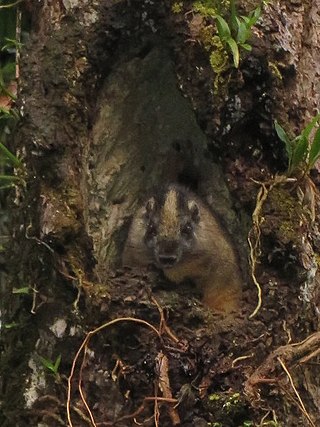
The toros or brush-tailed rats, genus Isothrix, are a group of spiny rats found in tropical South America, particularly in the Amazon Basin.
Owl's spiny rat is a rodent species in the family Echimyidae found in Brazil. It is the only species in the genus Carterodon. Owl's spiny rat has evolved characteristics such as a heightened ability to dig in open grasslands during times of environmental change.
The giant tree-rat is a species in the family Echimyidae, the spiny rats. It is the only species in the monotypic genus Toromys. It is endemic to Brazil, where it occurs in the flooded forest along the banks of the Amazon River and its tributaries.
The tuft-tailed spiny tree rat is a spiny rat species from Brazil south of the Amazon River, where it has been found in grassland and gallery forest. It is the only species in the genus Lonchothrix. Very little is known about this rodent. It is small with an average adult weight of about 138 grams. It is nocturnal and solitary in habits.

Mesomys is a genus of South American spiny rats in the family Echimyidae.
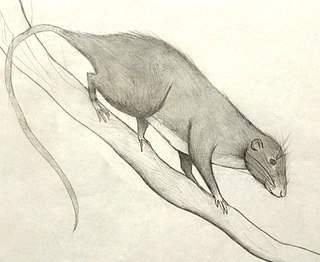
Dactylomys is the genus of South American bamboo rats They are arboreal members of the family Echimyidae.

Olallamys is a genus of Andean soft-furred spiny rat that range from Panama through Colombia and Venezuela to northern Ecuador. These species are typically found at elevations above 2,000 metres (6,600 ft).

Euryzygomatomys is a genus of South American rodents, commonly called guiaras, in the family Echimyidae. It contains two extant and one fossil species, found in Argentina, Brazil and Paraguay. They are as follows:

Diplomys is a genus of rodent in the family Echimyidae. They are found in Costa Rica, Ecuador, Colombia and Panama.
Makalata is a genus of rodents in the family Echimyidae.
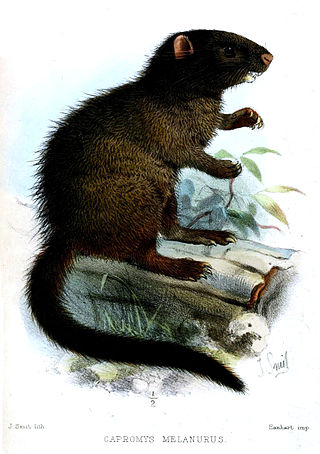
Mesocapromys is a genus of rodent in the subfamily Capromyinae. The genus is restricted to Cuba and associated islands.

Plagiodontia is a genus of rodent in the subfamily Capromyinae (hutias). All known species are endemic to the Caribbean island of Hispaniola.
Pattonomys is a genus of rodent in the family Echimyidae, named after American mammalogist James L. Patton. It contains the following species:
Clyomys is a South American rodent genus in the family Echimyidae. It contains two species, found in tropical savannas and grasslands from circa 100 m (300 ft) to 1,100 m (3,600 ft) elevation in central Brazil and eastern Paraguay.

Myocastorini is a tribe of echimyid rodents, proposed in 2017, and containing the five extant genera Callistomys, Hoplomys, Myocastor, Proechimys, and Thrichomys.
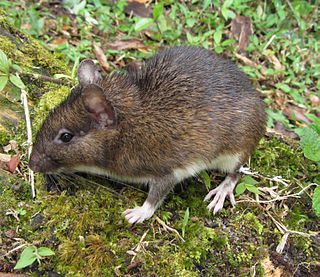
Euryzygomatinae is a subfamily of rodents, proposed in 2017, and containing three extant genera of spiny Echimyidae: Clyomys, Euryzygomatomys, and Trinomys.

Echimyini is a tribe of echimyid rodents, proposed in 2016, and containing 13 extant genera: all of the tree rats Echimys, Phyllomys, Makalata, Pattonomys, Toromys, Diplomys, Santamartamys, and Isothrix, the long recognized dactylomines Dactylomys, Olallamys, and Kannabateomys, and the enigmatic and previously classified as eumysopines Lonchothrix and Mesomys. All these spiny rats genera are arboreal. Worth of note, the arboreal genus Callistomys – the painted-tree rat – does not belong to the tribe Echimyini. Because it is phylogenetically closer to Myocastor, Hoplomys, Proechimys, and Thrichomys than to the above-mentioned Echimyini genera, it is classified in the tribe Myocastorini.

Echimyinae is a subfamily of rodents belonging to the spiny rats family Echimyidae. It contains 14 arboreal genera—all the members of the tribe Echimyini, plus Callistomys—a few terrestrial genera, and a subaquatic genus (Myocastor).
This page is based on this
Wikipedia article Text is available under the
CC BY-SA 4.0 license; additional terms may apply.
Images, videos and audio are available under their respective licenses.
